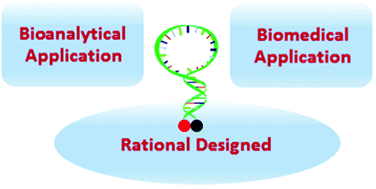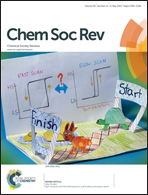Rationally designed molecular beacons for bioanalytical and biomedical applications
Abstract
Nucleic acids hold promise as biomolecules for future applications in biomedicine and biotechnology. Their well-defined structures and compositions afford unique chemical properties and biological functions. Moreover, the specificity of hydrogen-bonded Watson–Crick interactions allows the construction of nucleic acid sequences with multiple functions. In particular, the development of nucleic acid probes as essential molecular engineering tools will make a significant contribution to advancements in biosensing, bioimaging and therapy. The molecular beacon (MB), first conceptualized by Tyagi and Kramer in 1996, is an excellent example of a double-stranded nucleic acid (dsDNA) probe. Although inactive in the absence of a target, dsDNA probes can report the presence of a specific target through hybridization or a specific recognition-triggered change in conformation. MB probes are typically fluorescently labeled oligonucleotides that range from 25 to 35 nucleotides (nt) in length, and their structure can be divided into three components: stem, loop and reporter. The intrinsic merit of MBs depends on predictable design, reproducibility of synthesis, simplicity of modification, and built-in signal transduction. Using resonance energy transfer (RET) for signal transduction, MBs are further endowed with increased sensitivity, rapid response and universality, making them ideal for chemical sensing, environmental monitoring and biological imaging, in contrast to other nucleic acid probes. Furthermore, integrating MBs with targeting ligands or molecular drugs can substantially support their in vivo applications in theranositics. In this review, we survey advances in bioanalytical and biomedical applications of rationally designed MBs, as they have evolved through the collaborative efforts of many researchers. We first discuss improvements to the three components of MBs: stem, loop and reporter. The current applications of MBs in biosensing, bioimaging and therapy will then be described. In particular, we emphasize recent progress in constructing MB-based biosensors in homogeneous solution or on solid surfaces. We expect that such rationally designed and functionalized MBs will open up new and exciting avenues for biological and medical research and applications.



 Please wait while we load your content...
Please wait while we load your content...